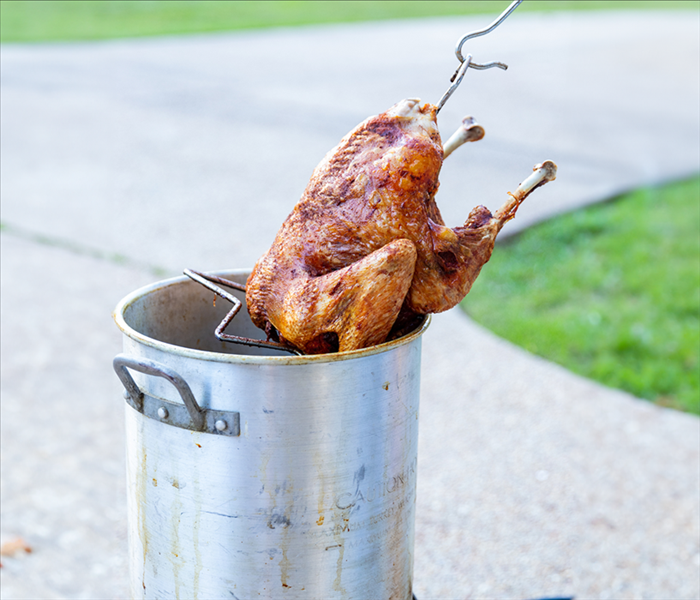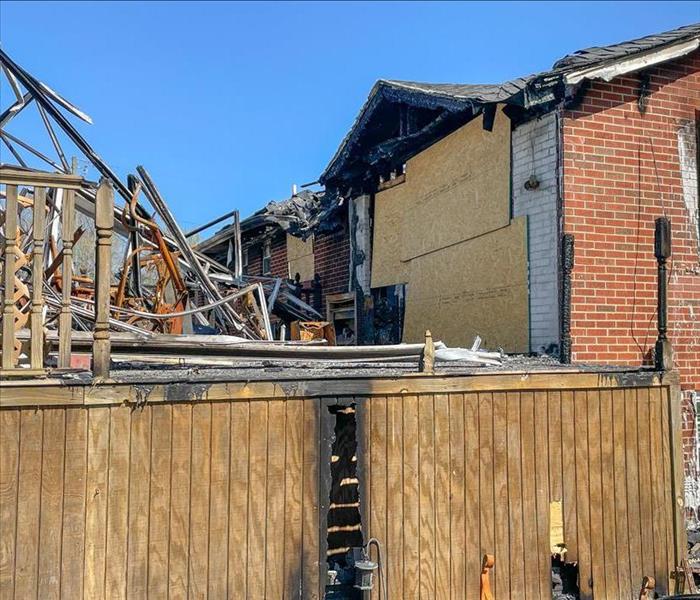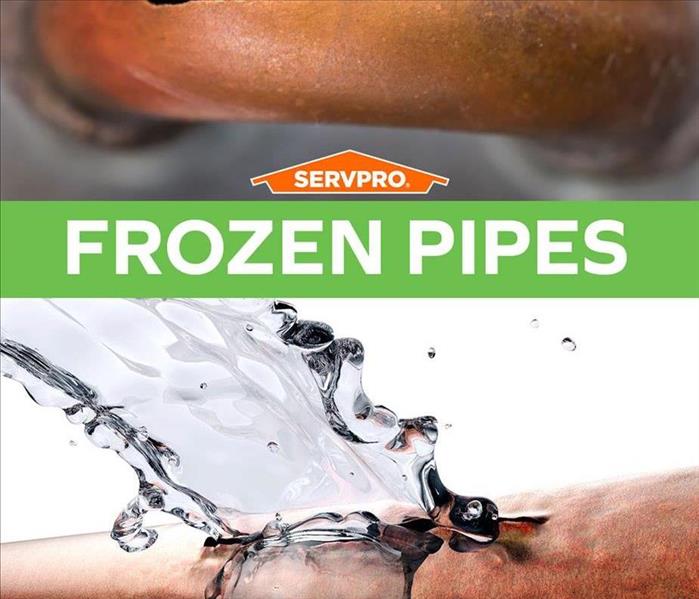Recent Posts
Don't Let a Frozen Pipe Burst Your Cozy Bubble
2/8/2024 (Permalink)
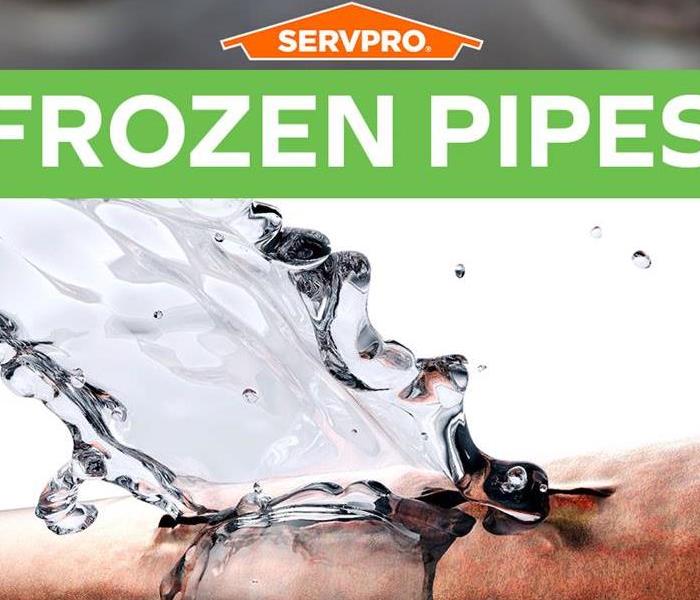 When pipes burst, SERVPRO of Bradley County is ready to respond and to make it, "Like it never even happened."
When pipes burst, SERVPRO of Bradley County is ready to respond and to make it, "Like it never even happened."
Cold weather is on the way. Are your pipes at risk of freezing? Let us help you get prepared with our checklist of preventative measures. But remember, if your pipes do undergo damage this winter, we are open 24/7, 365 days a year! Even though pipes bursting can be extremely inconvenient and devastating, SERVPRO of West Knoxville will be there to help you through it and to make it "Like it never even happened."
Checklist for preventing frozen pipes
- Insulate pipes located in the attic and crawl space using pipe insulation, even if the climate where you live does not often have hard freeze conditions. You can also wrap pipes in heat tape or heat cables with thermostat control. The best pipe insulation for your situation will depend on your home.
- Drain water from the swimming pool and water sprinkler supply lines following the manufacturer's or installer's directions. Do not put antifreeze in these lines unless directed. Antifreeze is environmentally harmful and dangerous to humans, pets, wildlife, and landscaping.
- Disconnect garden hoses from outdoor faucets. Even frost-proof outdoor faucets can burst if a hose is connected.
- Keep garage doors closed, especially if there are water supply lines in the garage.
- Open kitchen and bathroom cabinet doors to allow warmer air to circulate around the plumbing, especially if your sinks are on an exterior wall. (If you have small children, be sure to remove any harmful cleaners and household chemicals.)
- Let the cold water drip from the faucet served by exposed pipes. When the weather is very cold outside, running water through the pipe - even at a trickle - helps prevent pipes from freezing.
- Keep the thermostat set to the same temperature both during the day and at night. By temporarily suspending the use of lower nighttime temperatures, you may incur a higher heating bill, but you can prevent a much more costly repair job if pipes freeze and burst.
- Leave the heat on in your home. If you will be going away during cold weather, set the thermostat to a temperature no lower than 55° F.
Was this helpful? Leave us a review to let us know!
https://www.wereyouhappy.com/with/team-cuthbertson-chattanooga
Stay Warm and Safe: Heater Safety Tips for Winter
1/8/2024 (Permalink)
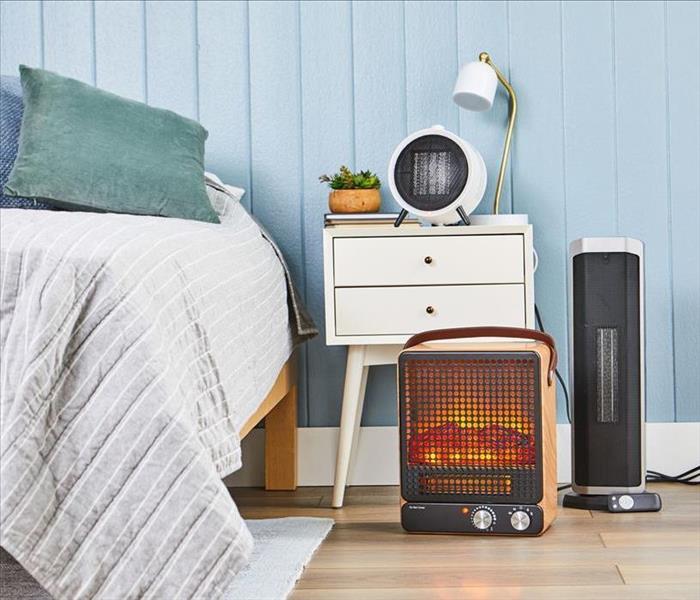
Stay Warm and Safe: Heater Safety Tips for WinterAs the winter chill sets in, many of us turn to heaters for a quick burst of warmth. But while heaters can be a lifesaver during cold snaps, it's crucial to prioritize safety when using them. Here are some key tips to keep you and your loved ones safe all winter long:
General Safety:
- Keep it Clear: Maintain a 3-foot "No-Burn Zone" around all heaters. This includes furniture, curtains, bedding, and anything else that could catch fire.
- Plug it Right: Never overload outlets. Plug space heaters directly into a wall socket; avoid using extension cords or power strips.
- Tip-Over Protection: Choose heaters with automatic shut-off features that activate if tipped over. This is especially important in homes with pets or children.
- Smoke and CO Alarms: Ensure your smoke and carbon monoxide detectors are functioning properly. Test them monthly and replace batteries as needed.
- Never Leave Unattended: Turn off and unplug heaters when leaving the room or going to bed.
Space Heater Safety:
- Electric vs. Fuel-Burning: Electric heaters are generally safer than fuel-burning models, as they don't produce carbon monoxide. However, electric heaters can still pose fire risks.
- Choose the Right Type: Select a heater with the appropriate wattage for the room size. Using an underpowered heater can cause it to overheat.
- Regular Maintenance: Inspect cords and plugs for damage before each use. Keep the heater clean and free of dust and debris.
Additional Tips:
- Consider Alternatives: If possible, use your central heating system for primary heating and space heaters for supplemental warmth.
- Dress in Layers: Wearing warm clothing can help reduce your reliance on heaters.
- Close Drafts: Seal leaks around windows and doors to prevent cold air from entering and improve heating efficiency.
By following these safety tips, you can enjoy the benefits of heaters without compromising your safety. Remember, a little caution goes a long way in preventing wintertime accidents.
Ensuring Turkey Fryer Safety for the Holidays
1/3/2024 (Permalink)
Ensuring Turkey Fryer Safety for a Happy Holiday Season
The holidays are a time for family, friends, and of course, a delicious turkey feast. While many families enjoy the tradition of deep-frying their turkeys, it is important to be aware of the potential safety hazards involved. SERVPRO, a leading provider of fire damage restoration services, is committed to helping families have a safe and enjoyable holiday season by providing turkey fryer safety tips.
Turkey Fryer Safety Tips
- Choose the Right Fryer: Always use a turkey fryer specifically designed for outdoor use. Never use an indoor turkey fryer, as they pose a high risk of fire.
- Use a Safe Location: Place your turkey fryer at least 10 feet away from any structures or combustible materials. Never operate a turkey fryer in a garage, shed, or any enclosed area.
- Keep Away from Flammables: Keep any flammable materials, such as propane tanks, gasoline, or lighter fluid, away from your turkey fryer.
- Fill with Proper Oil: Use only the recommended type of oil for your turkey fryer. Never overfill the fryer, as this can increase the risk of overflowing.
- Thaw the Turkey Completely: A partially frozen turkey can cause the oil to splatter and ignite. Always thaw your turkey completely before frying.
- Lower the Turkey Slowly: Slowly lower the turkey into the hot oil to avoid splattering.
- Never Leave the Fryer Unattended: Never leave a turkey fryer unattended while it is in operation. Always have a fire extinguisher nearby in case of an emergency.
- Dispose of Oil Properly: Once the turkey is cooked, allow the oil to cool completely before disposing of it. Never pour hot oil down the drain.
SERVPRO's Commitment to Safety
SERVPRO is committed to helping families have a safe and enjoyable holiday season by providing turkey fryer safety tips and fire damage restoration services in case of an emergency. With over 50 years of experience, SERVPRO has the expertise and resources to help you recover from a fire quickly and efficiently.
Enjoy a Safe and Happy Holiday
By following these turkey fryer safety tips, you can help prevent fires and ensure a safe and happy holiday season for you and your family. SERVPRO wishes you a safe and enjoyable holidays!
Fire Prevention for Homes and Businesses
12/12/2023 (Permalink)
If you didn't know, it's National Fire Prevention Week. As much as we here at SERVPRO are here to help clean up after fires, our priority is always to help prevent them in the first place. So, we want to share some tips with you that will help keep you and your loved ones safe.
Fire is one of the most devastating disasters that can strike a home or business. It can cause extensive damage to property and possessions, and can even lead to loss of life. That's why it's important to take steps to prevent fires from happening in the first place.
Here are some fire prevention tips for homes and businesses: Home fire prevention tips:
? Install smoke alarms on every level of your home, inside bedrooms and outside sleeping areas. Test your smoke alarms every month and change the batteries every year.
? Create and practice a fire escape plan with your family.
? Keep flammable materials away from heat sources.
? Be careful when cooking and using candles.
? Never smoke in bed.
? Have your electrical wiring and appliances inspected regularly by a qualified electrician.
Business fire prevention tips:
? Install smoke alarms and carbon monoxide detectors throughout your business. Test your alarms every month and change the batteries every year.
? Create and practice a fire escape plan with your employees.
? Keep flammable materials away from heat sources and electrical equipment.
? Be careful when using appliances and equipment.
? Have your electrical wiring and appliances inspected regularly by a qualified electrician.
How SERVPRO can help after a fire
If a fire does happen, it's important to call a qualified fire restoration company as soon as possible. SERVPRO is a leading provider of fire restoration services. We have over 2,000 franchises across the United States and Canada, so we're always nearby to help when disaster strikes.
Our team of highly trained and experienced professionals is equipped to handle all aspects of fire restoration, including:
? Emergency water removal
? Structural drying
? Smoke and odor removal
? Content cleaning and restoration ? Construction services
We work with your insurance company to make the claims process as easy and stress-free as possible. We also offer 24/7 emergency service, so you can always count on us to be there for you when you need us most.
If you have experienced a fire, contact SERVPRO today. We're here to help you get your home or business back to normal as quickly as possible. Additional fire prevention tips:
? Educate your family and employees about fire safety. Make sure everyone knows what to do in case of a fire.
? Have a fire extinguisher on every level of your home or business and know how to use it.
? Keep your fire extinguishers in good working order by inspecting them regularly and having them serviced by a professional.
? Consider installing a fire sprinkler system. Fire sprinkler systems can help to extinguish fires quickly and prevent them from spreading.
By following these fire prevention tips, you can help to protect your home or business from the devastating effects of fire.
Don't Let Frozen Pipes Ruin Your Holidays
12/19/2022 (Permalink)
The holidays are coming up. Keeping your home up-to-date is crucial to ensure that you can enjoy your holidays without any pipes bursting your bubble!
Begin the pipe burst cleanup. If any electrical outlets or equipment were disturbed, shut off electricity to the area. Use a wet vacuum or sump pump to remove any standing water and then clean, sanitize and dry any affected areas and items.
Keep in mind that an area that doesn’t dry quickly enough can develop black mold and lead to further damages to your property. To ensure the area is properly cleaned, sanitized and dried, you should work with a water cleanup company in Chattanooga, TN, that is experienced with commercial and residential pipe burst cleanup.
Our Technicians are certified in commercial and residential water damage cleanup. We are open 24/7/365 for you. Visit SERVPRO of Bradley County for more information on water cleanup.
Reopening Your Business After a Natural Disaster
12/5/2022 (Permalink)
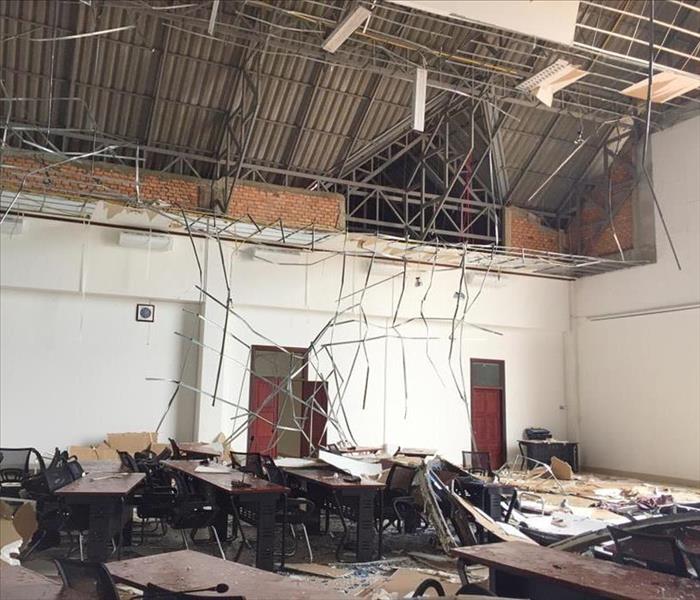 A natural disaster can be a devastating experience for any business.
A natural disaster can be a devastating experience for any business.
Opening Your Company Again Following a Natural Disaster
Natural disasters can strike at any time, and when they do, businesses need to be ready. In the aftermath of a natural disaster, many companies are understandably concerned about their employees and customers. But what about the business itself? How does a company get back on its feet after a natural disaster? The answer depends on the type of damage sustained by your business premises. Some building damage can be fixed relatively quickly, while other problems may take months or even years to resolve. This guide walks through some best practices for getting back up and running again after an earthquake or flood wreaks havoc on your city’s infrastructure—and ultimately helps keep both employees and customers happy in the process!
Have A Disaster Plan
Your business plan should include an outline of what you would do in the event of a disaster, how you would communicate with customers and suppliers, and how long it would take for your staff to get back up and running.
It can be helpful to have a template for this kind of plan in place before a disaster strikes so that you can quickly make adjustments as needed.
Call Your Insurance Company
You should call your insurance company as soon as possible to let them know that your business has been damaged. They will want to know the extent of the damage, and they will be able to tell you what kind of coverage your business has. They may also help you file claims for any damages, which can make it easier for you to get repairs done right away.
If it seems like there aren't any options for repairing or replacing equipment after a natural disaster damages your business, talk with an insurance agent about finding restoration companies in your area who can help with cleanup and rebuilding efforts so that everything is back up and running as soon as possible.
Keep Track of Your Contents
As you begin to get your business up and running, don’t forget about your business contents. You need to make sure that you have a plan for how to handle the insurance claims process in the event of a disaster. This will ensure that your belongings are accounted for and covered by an appropriate amount of insurance coverage after a natural disaster has occurred.
You should also consider having some sort of data recovery plan in place so that any lost data can be recovered quickly and efficiently after a natural disaster has occurred at your business's location. Your employees' personal effects should also be considered when working on this aspect of getting back into operation after a natural disaster has occurred.
Turn to FEMA for Help
Beginning the rebuilding process is daunting, but you can get help with FEMA. The agency provides resources for businesses in need of temporary housing, disaster loans, and other assistance after a natural disaster. FEMA also offers financial relief for businesses that were affected by natural disasters through its Small Business Administration (SBA) Disaster Loan Program.
Call a Professional for Cleanup
You should not try to clean up on your own. It is dangerous, and you could get hurt. You may damage your property and spread germs if you do not use proper safety gear, such as rubber gloves and respiratory masks. If you need to remove debris from the building, hire professionals.
You should know who is handling restoration services. This can be a contractor, vendor, or another business that specializes in disaster relief. Not only do they have the equipment and manpower to deal with the situation, but they also have a lot of experience doing so and will know what questions to ask when dealing with insurance companies and government agencies.
A natural disaster can be a devastating experience for any business, but it is important to remember that you are not alone. Many resources are available to help you get back on your feet and get back into the game of running your Cleveland, TN company. If you are unsure about what steps need to be taken next, talk with an insurance agent or someone else who has experience dealing with these types of situations before proceeding. The last thing anybody needs is more stress while trying to rebuild their lives after this terrible event! If your home or business is damaged by flood, fire, or storm, give SERVPRO of Bradley County a call!
What Is Category 3 Water Damage and How Do I Handle It?
11/1/2022 (Permalink)
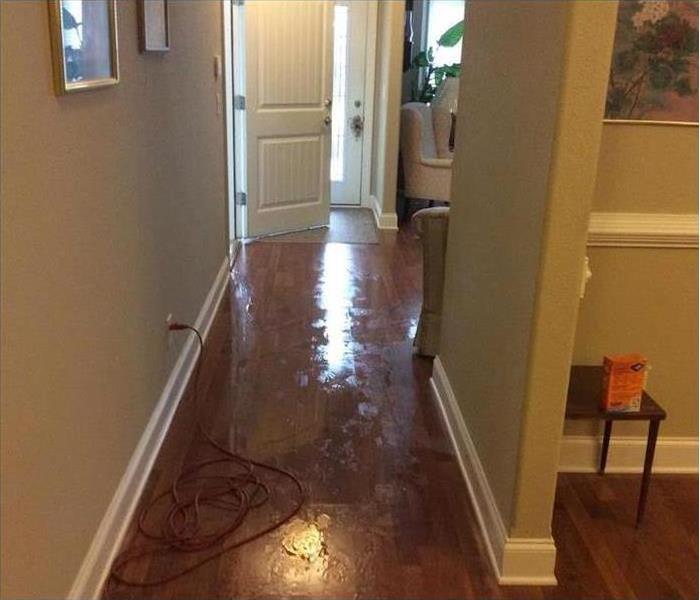 Category 3 water damage can result from standing water.
Category 3 water damage can result from standing water.
How Do I Handle Category 3 Water Damage?
Category 3 water damage is the worst-case scenario in home renovation. It's the type of water damage that results from sewage, standing water, and flooding from rivers, lakes, streams, and groundwater. A category 3 spill requires months of cleanup to get rid of any moldy odors that linger after a disaster strikes. This article will explain what Category 3 water is and how you can best handle it if it happens to your home or business.
What Is Category 3 Water Damage?
Category 3 water damage is a loss of water that exceeds the safe capacity of your home's drain system. This problem usually occurs during a heavy rainstorm, when sudden and severe downpours cause the drains to overflow or back up. If this happens, you may experience an immediate, but a short-lived flood. However, if there are any cracks in your foundation or below-ground pipes have been damaged due to corrosion or wear and tear, then it could take weeks for your home's foundation to dry out completely.
How Does Category 3 Water Get In My Home?
Category 3 water can get into your home in many ways. Some of which are more preventable than others:
- roof leaks (specifically those caused by flash floods)
- burst pipes (due to age)
- pouring rain onto ground saturated with groundwater (causing mudslides)
- sewer backups (due in part to clogged pipes)
- flooding caused by rising tides during high tides and hurricanes/tropical storms, etc.
How Does Category 3 Water Get in Your Home?
Category 3 water can enter your home through several sources, including broken pipes and leaking appliances. You may also have been exposed to category 3 water on the way home from work if you were in the vicinity of a flood or storm.
How Are Category 3 Water Losses Handled?
First, you want to call a professional water damage restoration company, like SERVPRO of Bradley County. Calling a professional will help ensure that the category 3 water loss is handled correctly. SERVPRO has equipment and expertise that you might not have and therefore are able to handle any category 3 water loss with ease. We work closely with your insurance, so you don’t have to worry about it as much.
If you have category 3 water in your home, it's critical to act quickly. Your personal safety is at risk and the longer you wait, the more damage category 3 water can do. If a family member becomes sick or if you notice an unusual odor—or if you see mold growing—it's time to call your insurance company and SERVPRO of Bradley County right away.
Category 3 water losses are a serious matter and should be handled by professionals. If you’re not sure if your loss is a category 3, give us a call today so we can help you determine the best course of action for your situation.
Why You Shouldn’t Clean Puffback Soot Yourself?
10/10/2022 (Permalink)
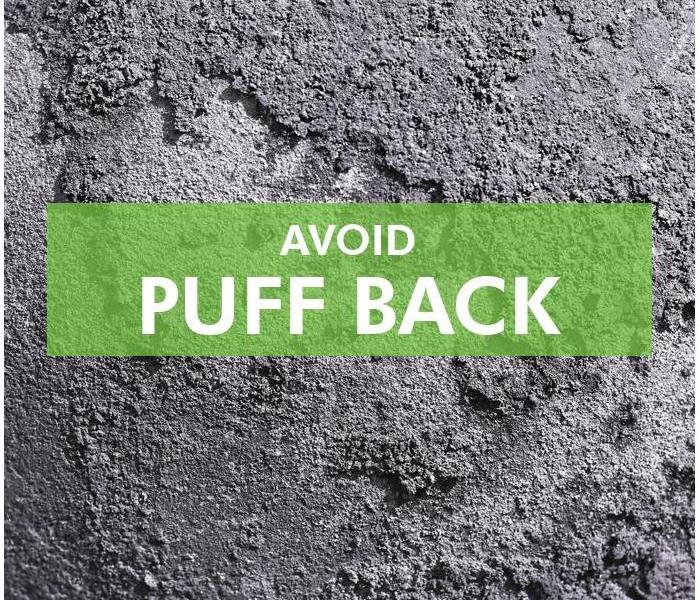 Puffback fires can cause secondary damage to your property.
Puffback fires can cause secondary damage to your property.
Puffback Soot Should be Cleaned by the Professionals
Soot is a substance that forms on the insides of chimneys and flues as a result of incomplete combustion. This can occur if your firewood is too damp or if the damper isn’t working properly. These soot deposits are called “puffbacks” because they resemble fluffy white clouds when expelled from your chimney. They can be extremely damaging to your property—causing secondary damage from water used in cleaning-up efforts, for example—and should be cleaned up only by SERVPRO professional restoration technicians with specialized equipment and expertise in handling these types of situations.
Puffback Soot Can Get into the Smallest Places
Puffback soot is a very fine and sticky substance that can get into even the smallest parts of your property. It’s not just on the walls and ceilings; it can be found in cracks in floor tiles, along baseboards, or even inside electrical outlets. If you clean this up yourself using water, you could end up damaging your property from all the water that will inevitably get used to put out the fire as well as cleaning-up efforts afterwards. We recommend having an expert team come in to clean your property without risking any damage to it.
Water is Secondary Damage to Your Property After a Puffback Fire
Don't clean up the soot yourself. Puffback fires can cause secondary damage to your property from water used to put out the fire, as well as from water used in cleaning-up efforts. Water can cause paint and other surface coatings to peel off walls and furniture, staining them permanently. Wood floors may warp and swell when exposed to too much moisture. Carpeting may become permanently stained by the chemicals you use to clean it up. Tile surfaces like flooring or countertops could crack if they absorb too much water at once (especially if they've been sealed). Upholstery fabrics could be damaged and torn by sharp tools like wire brushes that are used for cleanup jobs; likewise, furniture frames may splinter or crack if not properly covered during cleanup activities
Puffback soot is also very difficult to remove completely because it acts like an adhesive when wetted down with certain cleaning agents--so it's important that only non-toxic solvents be used for cleaning up this type of fire damage!
No DIY Puffback Cleanup
When you have experienced a fire, the last thing you want to do is clean it up yourself. You need a professional to take care of your property so that it’s safe and secure.
SERVPRO of Bradley County can help you with puffback damage. We will work closely with your insurance company to ensure that everything is handled professionally and efficiently.
If you have any questions or would like more information about puffback cleanup services in Bradley County, TN contact us today!
Business Contingency and Evacuation Planning in a Fire
8/30/2022 (Permalink)
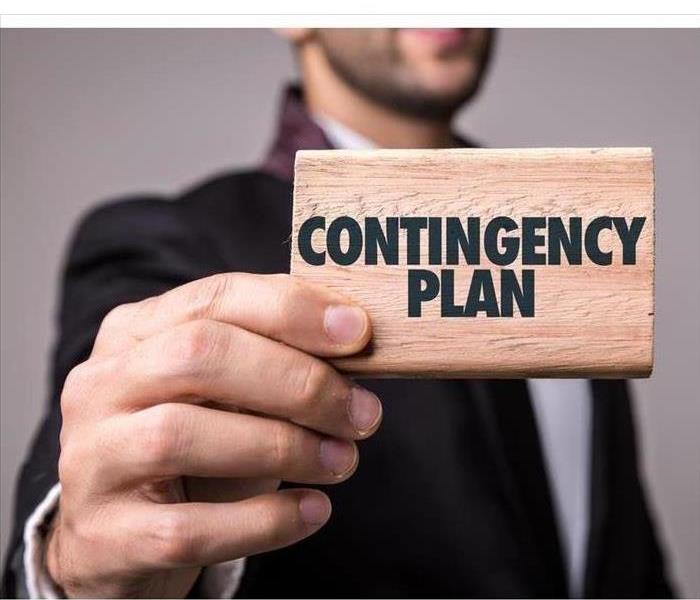 Your contingency plan must be executable not only by you, but also by everyone in your company.
Your contingency plan must be executable not only by you, but also by everyone in your company.
You never want to think of a fire breaking out at your Charleston, TN, business, but it’s better to plan for the worst and never see a moment’s danger than it is to hope for the best and face catastrophe without a plan. That’s why you need a fire contingency plan and safe evacuation strategy for your business – to protect yourself, your property, your employees, and your customers.Steps to Create a Contingency Plan
It’s not enough to just have a contingency plan in place. Your contingency plan needs to be executable not just by you, but by everyone in your business.
• Establish a designated evacuation plan and alternate routes. Determine the fastest, safest way to leave the building. Chart the route as part of documented procedures, but also ensure that each route has an alternate route in the event that others are blocked by fire or falling debris.
• Post evacuation and safety procedures near all exits and thoroughfares. Employees and customers alike should be able to immediately find a map of the safest evacuation route no matter where they are on your premises. Ensure that easy graphical instructions are available; most don’t have time or presence of mind to stop and read written instructions during a fire.
• Designate evacuation leaders. Your business should have two or more employees per shift who are designated as evacuation leaders, preferably more for backups. Your evacuation leaders are tasked with taking control of the situation and guiding others, especially customers who may not be familiar with drills.
• Ensure all employees have a handout with contact information for emergency personnel and documented safety procedures. Provide this information immediately on hire, and periodically reiterate.
• Conduct safety training drills. At least once per month, do random safety training/fire drills to reinforce protocols in an emergency.
• Periodically test all sprinklers and fire safety equipment. Smart planning will safeguard your people. Smart protections will safeguard your inventory and property. Make sure all fire extinguishers, sprinklers, and other fire safety equipment are operational and functioning up to spec.
IICRC Restoration Industry Certification Programs
8/23/2022 (Permalink)
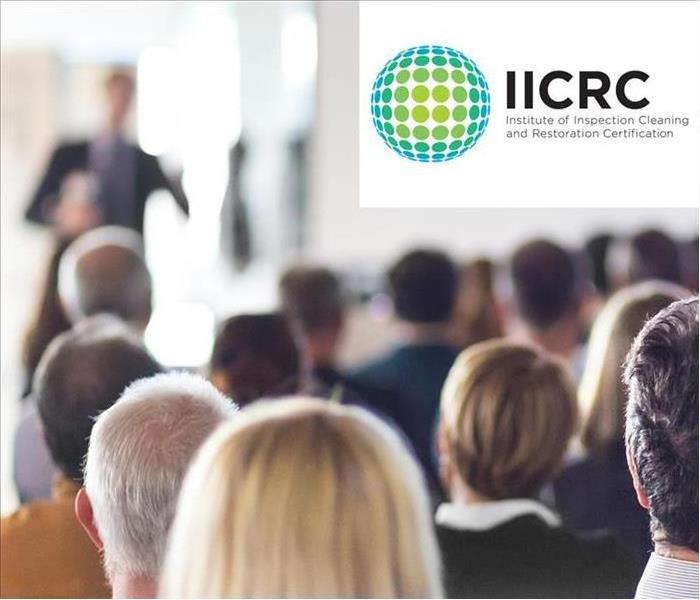 Our technicians undergo extensive water restoration training and certification through an IICRC-approved school.
Our technicians undergo extensive water restoration training and certification through an IICRC-approved school.
The Institute of Inspection Cleaning and Restoration Certification (IICRC), is a non-profit organization that serves the cleaning and restoration industry. Originally founded in 1972, the Institute now has more than 60,000 active certified technicians around the world. In addition to maintaining industry standards and offering continuing education and disaster resources, the Institute offers a variety of certification programs for both restoration firms and individual technicians.
Certifications Offered
Certification programs help ensure that restoration technicians have the necessary skills to complete their work safely and effectively. The Institute offers certification programs on a variety of topics relevant to the restoration industry:
- Applied Microbial Remediation Technician
- Applied Structural Drying Technician
- Building Moisture Thermography
- Commercial Drying Specialist
- Fire and Smoke Damage Restoration
- Technician
- Health and Safety Technician
- Trauma and Crime Scene Technician
- Water Damage Restoration Technician
A technician who wishes to move beyond the standard mitigation certificate may be able to pursue a master track in textile cleaning, fire and smoke restoration or water restoration. The Institute also offers the continuing education courses required to maintain these certificates.
Benefits of Certification
IICRC certified technicians are trained to perform at a high level in their field, which helps to build trust with employers, insurance companies and customers. Certification can serve to demonstrate that a technician has a high level of competence and commitment to maintaining their skills according to industry standards. Certification can also benefit employers by motivating employees to learn the latest technologies, providing advancement opportunities and increasing job and customer satisfaction.
How To Become Certified
A technician can become certified by taking an approved course and passing an exam. To maintain their certificate, technicians will need to pay a renewal fee and complete continuing education courses. Technicians may be able to pursue a master certification after at least three consecutive years of being a certified technician.
IICRC certification offers many benefits for both technicians and their employers. Interested technicians can begin their path towards certification by taking an approved course at a school in East Cleveland, TN.
 When pipes burst, SERVPRO of Bradley County is ready to respond and to make it, "Like it never even happened."
When pipes burst, SERVPRO of Bradley County is ready to respond and to make it, "Like it never even happened."






 24/7 Emergency Service
24/7 Emergency Service

